augustus 23rd, 2009
Persijn Broersen & Margit Lukács
Manifest Destiny, 2009
Serie of silkscreens, 120 x80 cm.
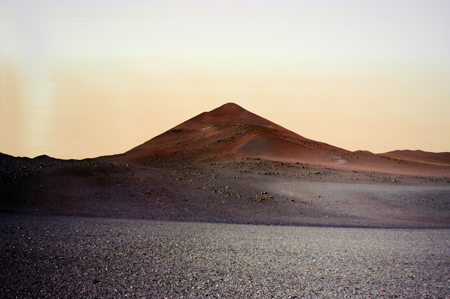
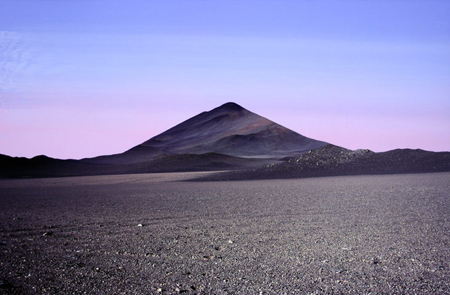
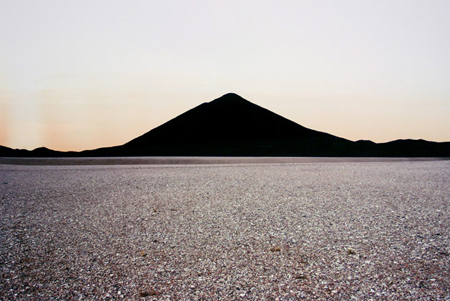
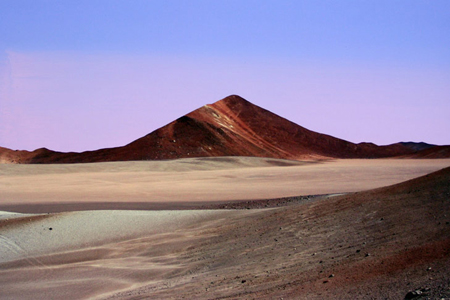
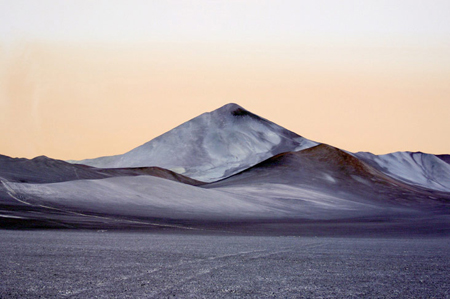
In the silk-screens one sees an imaginary sky that is silkscreened over photographs of a barren desert where some of the Mars mobiles have been tested. In these works Broersen & Lukacs investigate the notion close up and distance, of horizon and the frontier, in relationship to the American tradition of the sublime landscape.
James Turell
Roden Crater, 1979 – 2011

Roden Crater is an extinct volcano crater northeast of Flagstaff, Arizona. Artist James Turrell purchased the 400,000 year old, 3 km wide crater in 1979 and has been transforming it into a massive naked-eye observatory, designed specifically for the viewing of celestial phenomena. He stated that he plans to open the crater for public viewing in 2011.
TIMES-ONLINE: Man-made volcanoes may cool Earth
August 30, 2009
THE Royal Society is backing research into simulated volcanic eruptions, spraying millions of tons of dust into the air, in an attempt to stave off climate change. The intervention by the Royal Society comes amid tension ahead of the United Nations-sponsored climate talks in Copenhagen in December 2009 to agree global cuts in carbon dioxide emissions. Preliminary discussions have gone so badly that many scientists believe geo-engineering will be needed as a “plan B”.
The interest in so-called aerosols is linked to the eruption of Mount Pinatubo in the Philippines in 1991, the second largest volcanic eruption of the 20th century. The explosion blasted up to 20m tons of tiny sulphur particles into the air, cooling the planet by about 0.5C before they fell back to earth. The Royal Society is Britain’s premier science institution and its decision to take geo-engineering seriously is a measure of the desperation felt by scientists about climate change.
Based on a text by Jonathan Leake, Environment Editor of The Times.
Posted in Geomorphology, Visual Arts | Reacties uitgeschakeld voor The Possibility of a Mountain
augustus 22nd, 2009
Leo Fabrizio
Swiss Bunkers, 1999-2004
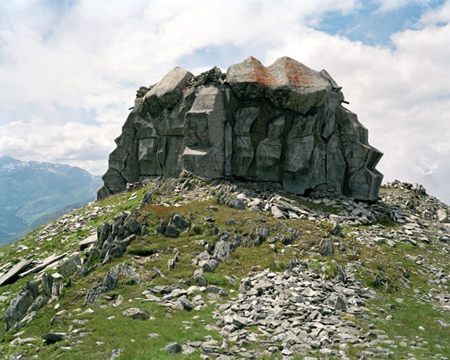
Switzerland is riddled with hidden and disguised military installations. What appeared to be a rock face in a lay-by beside the road were actually steel and concrete doors painted like rock. A five years study by, questioning landscape and identity. Is the territory surrounding us influencing our identity? What happens then when this territory, reputed to be wild and pure, is in fact completely manipulated by humans?
‘After the cold war ended many of the bunkers became obsolete. The tendency is to forget them or even to renounce them, my approach on the contrary, aims to expose them from a new angle. This approach has led me to discover a great number of bunkers, some in remote areas, sometimes difficultly accessible, covering the whole of the Swiss territory. The relations between these basic shaped bunkers and the often-sumptuous landscape surrounds them became an essential part of the study. I looked for the most spectacular bunkers, notable for their camouflage devices, true theatre scenery made with the utmost care. A quality indeed fully Swiss.’ – Leo Fabrizio –
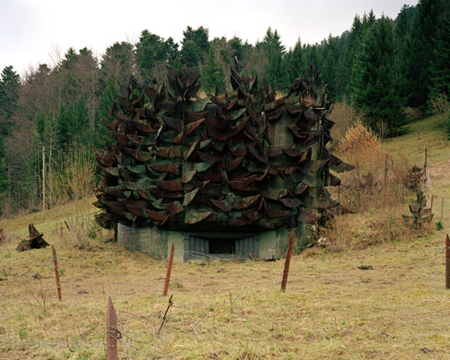
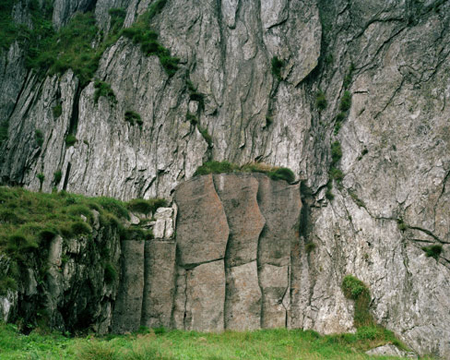
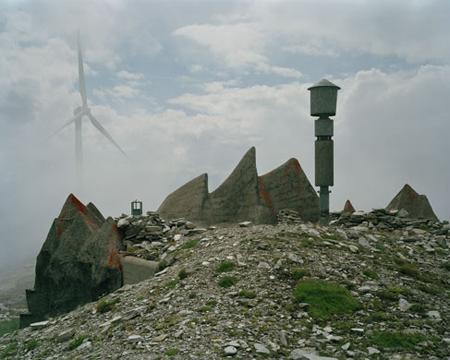
Posted in Geomorphology, Sociology | Reacties uitgeschakeld voor Neutral Bunkers
augustus 22nd, 2009
Peter Fend
Ocean Earth Construction and Development Corporation, 1980
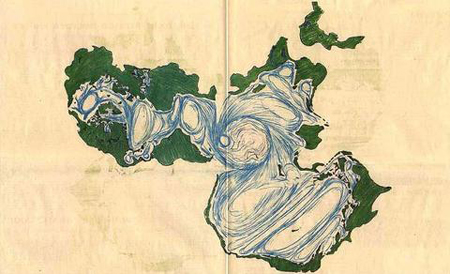
The aim of the Ocean Earth Construction and Development Corporation is research on alternative energy sources. They use satellite imaging to monitor and analyze global ecological and geopolitical hot-spots, largely for media clients. Considering the world a living earthwork, ecological aspects are linked to and interconnected with artistic aspects. Ocean Earth was conceived as an instrument for implementing the goals of the environmental art movement, directly building upon the ideas of artists such as Joseph Beuys, Robert Smithson and Gordon Matta-Clark. Through inter-disciplinary collaborations and by connecting ecological imperatives with experimental new technologies, Fend asks ‘How far can art go?’, in drawing attention to a belief that artistic research can generate productive dialogue about global ecological problems and that it can be used to develop effective solutions.
Local Fuel Production – Afganistan Iran Holland, 2009
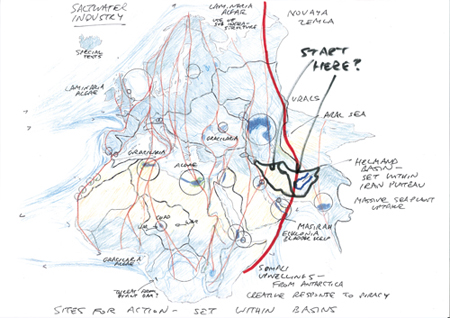
Maquette of Afganistan basin as skatepark
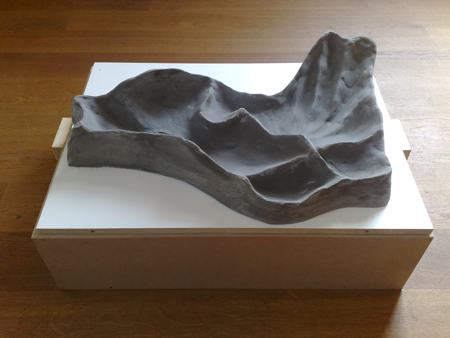

Posted in Ecology, Geomorphology, Visual Arts | 2 Comments »
augustus 2nd, 2009
Pierre Huyghe
Timekeeper, 1999.
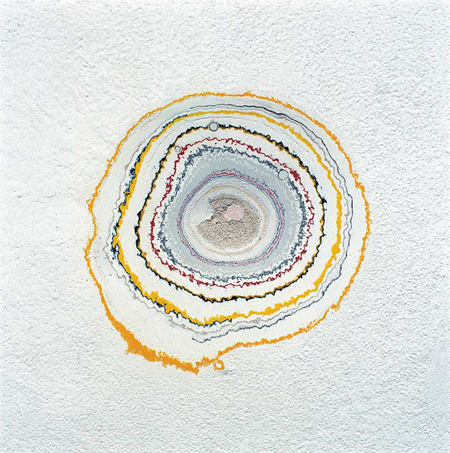
Installation view of a hole revealing wall painting of successive exhibition layers, 20 cm in diameter at the Viennese Secession. Like A geographical cross-section, Timekeeper uncovers and shows the successive layers left behind by previous actions (wall paintings) on the walls of the Wiener Secession. Just as the rings of a tree tell its history. Timekeeper is a caption that tells the story of its location. It allows the work of different artists to coexist. A kind of retrospective and group exhibition. 2003
“It’s very difficult to say what’s poetic in my work because it’s not something ‘mathematical’. It’s not a recipe. There’s no reason to have a recipe and say that I’m going to be poetic. I never do that. It’s rarely within the form itself. It’s more in the process. If there is something poetic, it’s poetic in the procedure . . . in the way things are made.”
– Pierre Huyghe
Maya Lin
Atlas Landscape, 2006
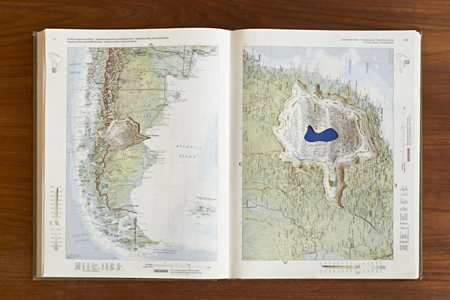
Caspian Sea, 2006
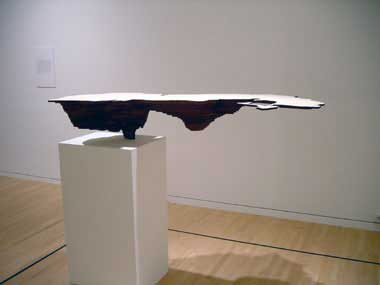
Posted in Stratigraphy, Visual Arts | Reacties uitgeschakeld voor Systematic Landscapes
juli 31st, 2009
Christopher Locke
Modern Fossil – Asportatio Acroamatis, 2009
(commonly referred to as the Cassette Tape)
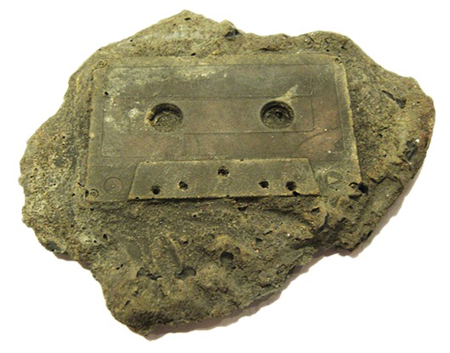
‘These Modern Fossils are made from actual archaic technology that was once cutting-edge. Most of these examples were discovered in the United States, although the various species are represented all over the world. It is sad, but most of these units lived very short lives. Most people attribute the shortened lifespan to aggressive predators or accelerated evolution, but this is not necessarily true. It has been shown recently that the true demise of most of these specimens came from runaway consumerism and wastefulness at the high end of the food chain.
This species was first seen in the mid 1960s, but is not widespread until the 1970s. Similar to Repondecium antiquipotacium, it is thought that the compact disc lead to the decline in the Asportatio acroamatis population in the late 1990s. Asportatio has often been found in close proximity to Ambulephebus sonysymphonia, suggesting a close relationship between the two species’.
– Christopher Locke –
Dominaludus Sexagentaquad, 2009
(commonly referred to as the Nintendo 64 Controller or “N64”)

Deferovoculae Cellarius
(commonly referred to as “Cellular Phone” or “Cellphone”. This particular example is a “Motorola Meteor”)
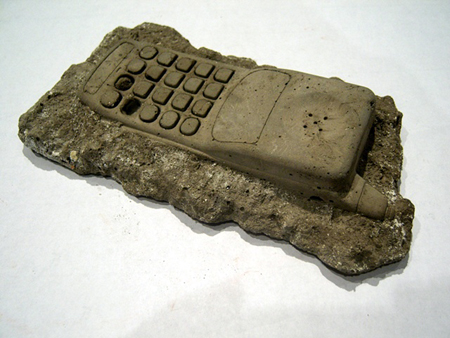
Posted in Archaeology, Garbology, Geology, Paleontology | Reacties uitgeschakeld voor Modern Fossils
april 30th, 2009
Charles Avery
The Islanders: An Introduction, 2004 – ….
For the past four years, Scottish artist Avery has created texts, drawings, installations and sculptures which describe the topology and cosmology of an imaginary island, whose every feature embodies a philosophical proposition, problem or solution.
Untitled (World View), 2008
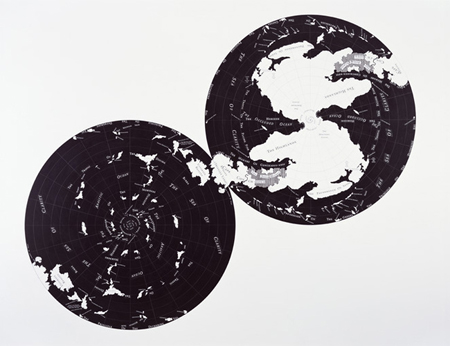
Avery’s mapping of the Island, to be completed over a projected ten-year period, can be interpreted as a meditation on making art and the impossibility of finding “truth”. The artist is characterised as a bounty-hunter, retrieving artifacts and documenting scenes from the subjective realm. Some of the works on show will focus in absurd detail, on particulars such as the sale of pickled eggs in the marketplace. Others present mysterious landscapes, such as the “Eternal Forest”, a place no one can ever reach but where a prized beast called the Noumenon is rumoured to live. A specimen of the Island’s wildlife will also be on show, having been realised in the form of a large taxidermy sculpture. These vivid and intricate works invite the viewer to recreate the Island in their own minds, and to use it as an arena for exploring philosophical conundrums and paradoxes.
Untitled (Stone-Mouse Display), 2008

Untitled (Noumenon)
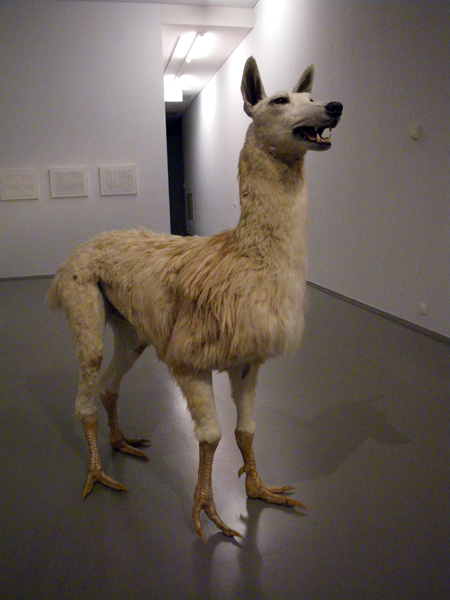
Untitled (Aleph-Nul)
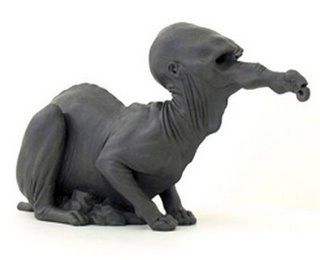
Posted in Cryptozoology, Petrology, Visual Arts | Reacties uitgeschakeld voor Noumenon Conundrum
maart 3rd, 2009
Eleanor Kent
Electroluminiscent Coral, 2007
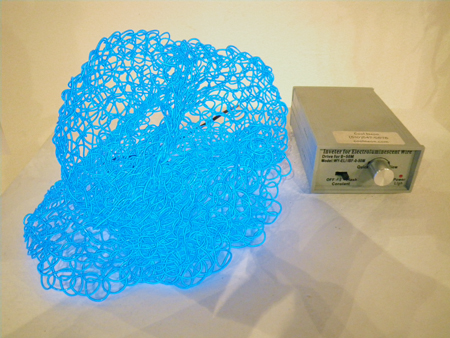
This work by Eleanor Kent was part of a larger display at Track16 Gallery in Los Angeles (02/2009) of the ever growing Hyperbolic Crochet Coral Reef made by The Institute For Figuring and crocheting fans all over the world. (See also previous post)
One of the acknowledged wonders of the natural world, the Great Barrier Reef stretches along the coast of Queensland Australia, in a riotous profusion of color and form unparalleled on our planet. But global warming and pollutants so threaten this fragile marvel that it may well be gone by the end of the century. In homage to the Great One, Christine and Margaret Wertheim of The Institute For Figuring have instigated a project to crochet a handmade reef, a woolly testimony that now engages thousands of women the world over.
As a response to the ecological crisis facing marine environments, the Crochet Reef project has been called by Ren Weschler “the Aids Quilt of Global Warming.” What began as a tiny seed in the Wertheim’s home in Highland Park has morphed organically into a worldwide movement – Sister Reefs have now been made in Chicago, New York and London, with other efforts currently under way in Sydney, Arizona and Latvia. For the first time, in this exhibition, Crochet Reefs are brought together from around the globe, massing into an archipelago of stunning craft finesse.
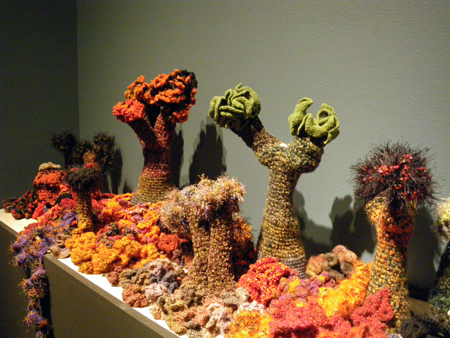
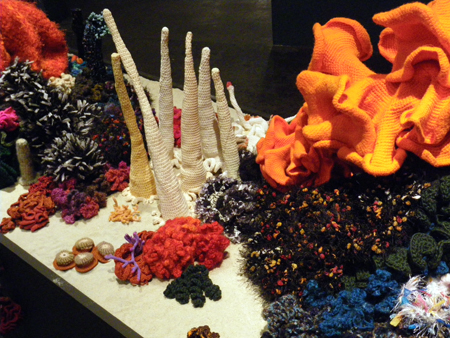
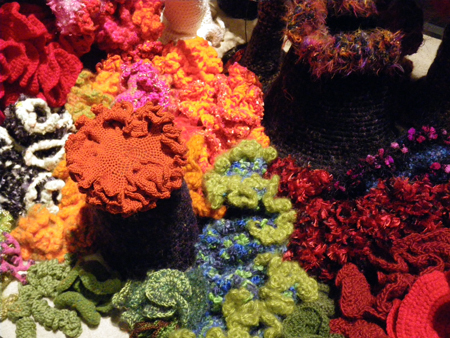
Posted in Ecology, Oceanography, Visual Arts | Reacties uitgeschakeld voor Coral Crocheting II
februari 25th, 2009
Maarten Vanden Eynde
Platic Reef – sample, 2009
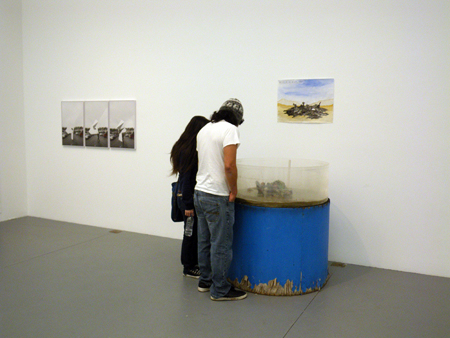
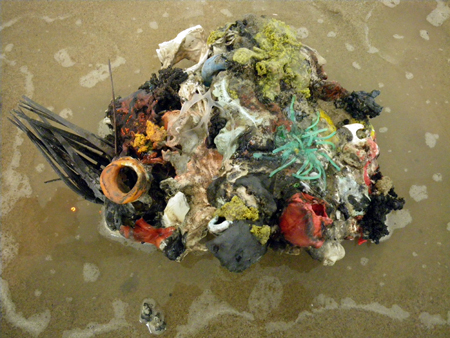
THIS IS THE FUTURE BEFORE IT HAPPENED…
(title of exhibition curated by Julie Deamer – Glendale, USA, 02/2009)
A “floating landfill”, twice the size of Texas and made up of plastic particles was swirling about 1,000 miles west of California and 1,000 miles north of the Hawaiian Islands. The trash collected in one area, known as the North Pacific Gyre, due to a clockwise trade wind that circulated along the Pacific Rim. While the plastic trash floated along, instead of biodegrading, it was “photodegrading,” — the sun’s UV rays turned the plastic brittle, much like they would crack the vinyl on a car roof. They broke down the plastic into small pieces and, in some cases, into particles as fine as dust.
Charles Moore, marine researcher at the Algalita Marina Research Foundation in Long Beach who discovered the plastic in 1997 and has been studying and publicizing the patch for the past 20 years, said the debris — which he estimates weighed 3 million tons and covered an area twice the size of Texas —was made up mostly of fine plastic chips and impossible to skim out of the ocean. Also, it was undetectable by overhead satellite photos because 80 percent was plastic and therefore translucent. The plastic moved just beneath the surface, from one inch to depths of 300 feet, according to samples Moore collected .
Ironically, the debris was re-entering the oceans whence it came; the ancient plankton that once floated on Earth’s primordial sea gave rise to the petroleum, being transformed into plastic polymers. That exhumed life, our “civilized plankton,” was, in effect, competing with its natural counterparts, as well as with those life-forms that directly or indirectly fed on them. Inside the North Pacific Gyre the natural plankton was outnumbered 6 to 1 in favor of the plastic plankton. The scale of the phenomenon was astounding. Plastic debris became the most common surface feature of the world’s oceans. What could be done with this new class of products made specifically to defeat natural recycling? How could the dictum “In ecosystems, everything is used” be made to work with plastic ? So far no organism was able to digest plastik plankton or transform it again into something organic, closing back the broken chain of life.
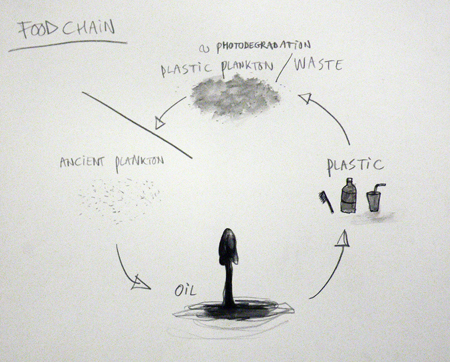
In February 2010 the Belgian artist Maarten Vanden Eynde (1977), based in Rotterdam, The Netherlands, went to the North Atlantic Gyre with a boat to collect 5 tons of plastic debris. He melted it into a huge plastic coral reef and shipped it to Oman. There, in the middle of a dried out sea, located in a dessert called ‘Mother of All Poisons’ (due to the hazardous environmental conditions), he placed the new coral reef as a landart sculpture, a remnant of a forgotten present discovered in a possible future.
Posted in Ecology, Oceanography, Photobiology, Visual Arts | Reacties uitgeschakeld voor THIS IS THE FUTURE BEFORE IT HAPPENED…
februari 6th, 2009
Rachel Whiteread
House, 1993
concrete, (destroyed)
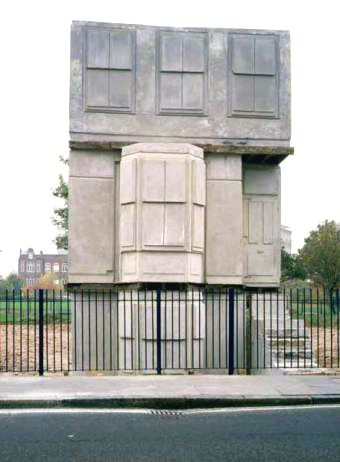
House, perhaps Whitereads best known work, was a concrete cast of the inside of an entire Victorian terraced house completed in autumn 1993, exhibited at the location of the original house — 193 Grove Road — in East London (all the houses in the street had earlier been knocked down by the council). It drew mixed responses, winning her both the Turner Prize for best young British artist in 1993 and the K Foundation art award for worst British artist.
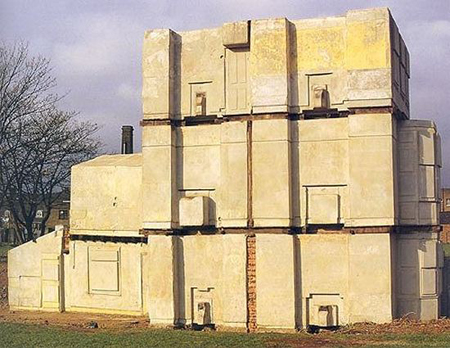
Nineteenth-century sculptors referred to the process of bronze casting as life, death, and resurrection as the original live object was destroyed in the casting process and resurrected in bronze. In a similar but distinctly different manner Rachel Whiteread casts the space inside, around, and adjacent to objects that have been part of people’s lives. This process and her choice of materials transform the residue of everyday life into ghostlike, uncanny spirit images of everyday objects.
Rather than using the traditional casting process of making molds of objects and then casting them in a different material, Whiteread uses the objects themselves as molds. For example her 2002 sculpture “Sequel IV”, is a casting of the enclosing space surrounding the backs of a library shelf done in plaster. This is a reversal of a bookshelf as the titles are hidden and the books inaccessible. Instead of inviting browsing, these books are inaccessible shadows, frozen in time, reflecting hidden knowledge. It is as if we came upon an ancient ruin of a library.
Sequel IV, 2002
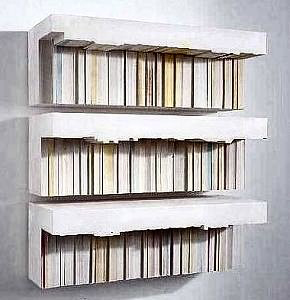
Text by Damon Hyldreth
Posted in Archaeology, Petrology, Visual Arts | Reacties uitgeschakeld voor Concrete Casting
januari 20th, 2009
Folded rock in Namib desert (Southern Africa)

When Einstein wrote his general theory of relativity in 1915, he found a new way to describe gravity. It was not a force, as Sir Isaac Newton had supposed, but a consequence of the distortion of space and time, conceived together in his theory as ‘space-time’. Any object distorts the fabric of space-time and the bigger it is, the greater the effect.
Just as a bowling ball placed on a trampoline stretches the fabric and causes it to sag, so planets and stars warp space-time – a phenomenon known as the ‘geodetic effect’. A marble moving along the trampoline will be drawn inexorably towards the ball.
Thus the planets orbiting the Sun are not being pulled by the Sun; they are following the curved space-time deformation caused by the Sun. The reason the planets never fall into the Sun is because of the speed at which they are travelling. According to the theory, matter and energy distort space-time, curving it around themselves.
- Anushka Asthana and David Smith, The Observer -
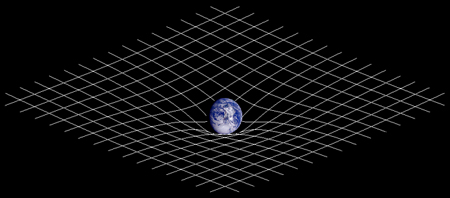
Two-dimensional analogy of space-time distortion.
Posted in Philosophy, Stratigraphy | Reacties uitgeschakeld voor Curved Space
januari 18th, 2009
Walter De Maria
Vertical Earth Kilometer, 1977
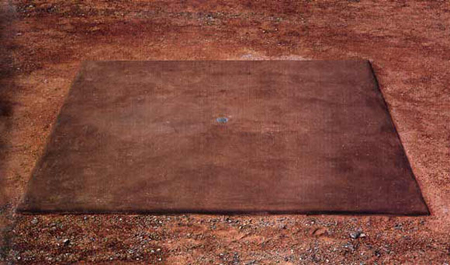
A km-long rod of metal was buried vertically in the ground. The boring of the shaft, which goes through six geological layers, took seventy-nine days. The continuous metal rod is made of 167 m-long rods, screwed tightly together. The sandstone square which surrounds the top of the shaft is at the intersection of two paths which traverse the Friedrichsplatz in Kassel, Germany, site of theinternational contemporary art serveys, Documenta. The work is only visible in section: the kilometer of metalplunged into the earth can be seen as a representation of time in a vertical dimension.
- from 'Land and Environmental Art' by Jeffrey Kastner and Brian Wallis, PHAIDON -
Walter De Maria
The Broken Kilometer, 1979
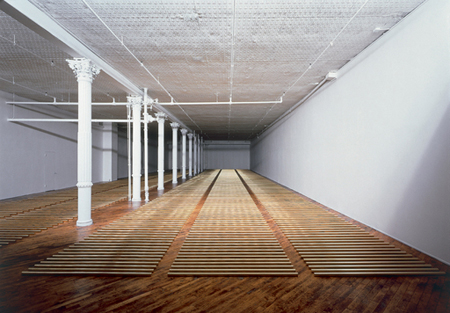
Courtesy Dia Art Foundation © the artist. Photo: John Abbott
500 brass rods, permanently installed at 393 West Broadway, New York City
Each rod 200x5cm
With The Broken Kilometer, De Maria had put in place the fourth and last stage of his multi-part sculptural system. While the solid brass work in Kassel plunged a kilometre into the ground and The Lightning Field in New Mexico marked out an area of one kilometre by one mile with poles that all reached the same, absolute height, in 1977 he created The New York Earth Room – apparently permanently – by covering the entire floor of a room in Friedrich’s other SoHo gallery with an even layer of earth. The work can still be seen on the second floor at 141 Wooster Street. Two years later, when The Broken Kilometer – filling the whole floor space of a gallery – was installed as a permanent exhibition, it was clear that the viewer who encountered the piece in astonishment could only respond in one way: silent contemplation. – Thomas Kellein director Kunsthalle Bielefeld.
Posted in Archaeology, Geography, Visual Arts | Reacties uitgeschakeld voor Time as a Vertical Dimension
januari 6th, 2009
Edward Burtynsky
Kennecott Copper Mine No. 22, Bingham Valley, Utah, 1983
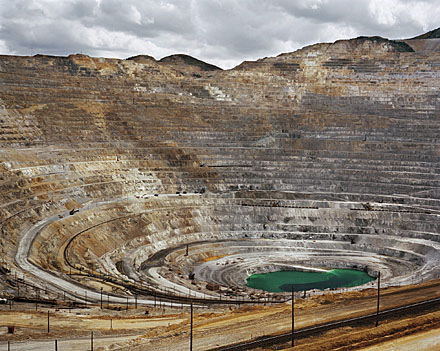
‘Nature transformed through industry is a predominant theme in my work. I set course to intersect with a contemporary view of the great ages of man; from stone, to minerals, oil, transportation, silicon, and so on. To make these ideas visible I search for subjects that are rich in detail and scale yet open in their meaning. Recycling yards, mine tailings, quarries and refineries are all places that are outside of our normal experience, yet we partake of their output on a daily basis’. – Edward Burtynsky –
Tanggu Port, Tianjin, 2005
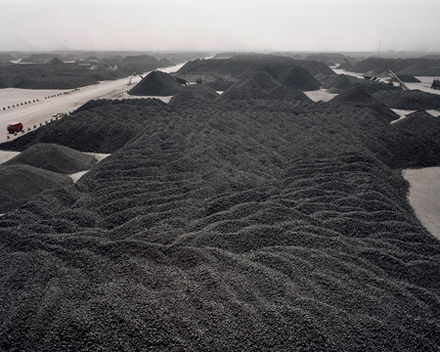
‘These images are meant as metaphors to the dilemma of our modern existence; they search for a dialogue between attraction and repulsion, seduction and fear. We are drawn by desire – a chance at good living, yet we are consciously or unconsciously aware that the world is suffering for our success. Our dependence on nature to provide the materials for our consumption and our concern for the health of our planet sets us into an uneasy contradiction. For me, these images function as reflecting pools of our times’.
– Edward Burtynsky –
Oxford Tire Pile No. 5, Westley, CA, 1999

Oil Fields No. 13, Taft, California, 2002
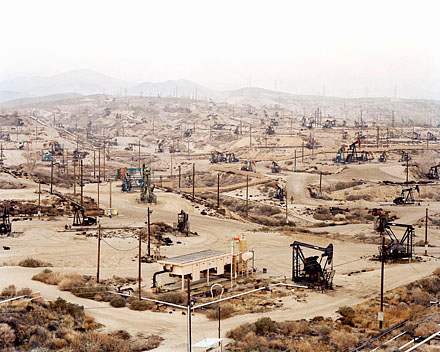
Urban Renewal #5, City Overview From Top of Military Hospital, Shanghai, 2004
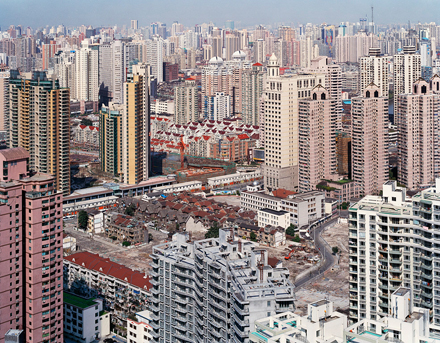
Posted in Ecology, Geography, Sociology, Visual Arts | Reacties uitgeschakeld voor Landscaping
december 30th, 2008
Nobuo Sekine
Phase — Mother Earth, 1968
(270 x 220 cm)
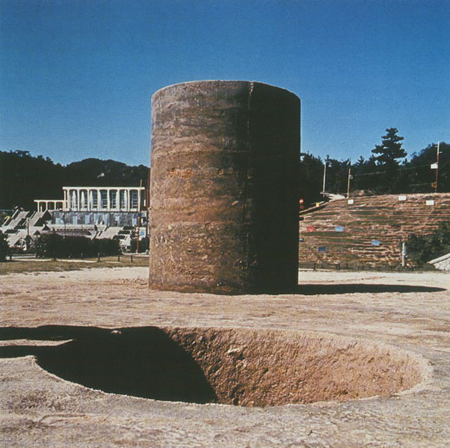
In October 1968 Nobuo Sekine dug a hole in the ground, shaped the extracted dirt into a large cylinder and called the work “Phase — Mother Earth.” It was probably an experiment, influenced by discussions of the new Land Art and Minimalist works taking place in the United States.
When it was first constructed, the prevailing view in Japan was that it was kind of quirky visual play of positive and negative spaces. But artist Lee Ufan disagreed, claiming that this was actually the end of visual manipulation; it was in fact a real time, real life absence and presence presented in temporal juxtaposition — a before and an after.
This, Sekine’s piece and Lee’s comment, is typically pointed to as the founding moment of Japan’s influential, homegrown Mono-ha art movement.
Born into the post-war years and the supposed ruins of consumer culture, a small group of artists were attempting to create a new, utopian reality. They proceeded as if art might be re-enchanted by shifting attention away from the objectification of images and to the creation of a world of encounters, with everyday objects, that might end up looking like mythic gestures.
Mono-ha, literally “the school of things,” was initially an informal term — sometimes used derisively — that brought together loosely affiliated artists around Tokyo including Sekine, Lee, Susumu Koshimizu, Katsuro Yoshida, and 12 or so others.
By MATT LARKING
Special to The Japan Times

“Faced with this solid block of raw earth, the power of this object of reality rendered everybody speechless, and we stood there, rooted to the spot… I just wondered at the power of the convex and concave earth, the sheer physicality of it. I could feel the passing of time’s quiet emptiness… That was the birth of ‘Mono-ha’. – Nobuo Sekine
Posted in Archaeology, Geology, Stratigraphy, Visual Arts | Reacties uitgeschakeld voor Sampling Mother Earth
november 6th, 2008
Maarten Vanden Eynde
Mon(NU)mentum, 2008 AD
(450 x 60 cm)

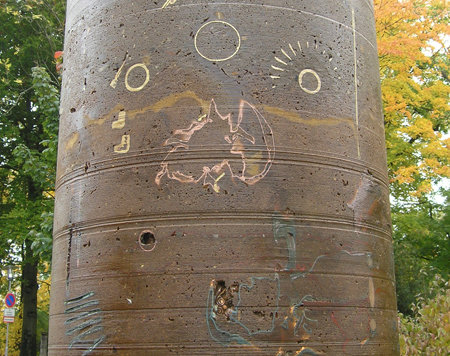
Time is a philosophical dimension, a basic substance which we breath in and out constantly. Just like space it is always there. Time experience however seems to be working on many different levels in an ever changing and more personalized speed (sometimes a minute can last forever and your life can fly by in a fraction). Time is not static, it is always on the move. The impossibility to stop time is mirrored by the impossibility to live in the present. ‘Now’ is an elusive point between the past and the future. Like the gardener on his way to Ispahaan, the present is on his way to an unavoidable destiny: the past. There is no escape. When you read THIS word, it became history already. The future is catching up instantly. What is the force that powers the engine of time? Is the present being pulled towards the future?
The Universal Law of Gravitation has several important features. First, it is an inverse square law, meaning that the strength of the force between two massive objects decreases in proportion to the square of the distance between them as they move farther apart. Second, the direction in which the force acts is always along the line (or vector) connecting the two gravitating objects.
In 1687 Sir Isaac Newton first published his Philosophiae Naturalis Principia Mathematica (Mathematical Principles of Natural Philosophy) which was a radical treatment of mechanics, establishing the concepts which were to dominate physics for the next two hundred years. Among the book’s most important new concepts was Newton’s Universal Law of Gravitation. Newton managed to take Kepler’s Laws governing the motion of the planets and Galileo’s ideas about kinematics and projectile motion and synthesize them into a law which governed both motion on earth and motion in the heavens. This was an achievement of enormous importance for physics; Newton’s discoveries meant that the universe was a rational place in which the same principles of nature applied to all objects.
Could it also work for Time?
Between two objects, let’s say A and B, there is a point where the gravitation of both objects is working with equal force (L1 point, named after Lagrange ). This point is balancing between the two attracting masses. If it is slightly bending towards A or B is will be attracted more by either one of them. It can only move from it’s frozen position, without loosing it’s equal balance, if A and B change mass simultaneously. The mass A is loosing, B has to gain. If time would be a linear experience, and A would be the past and B the future, than the point (C) hanging in the middle would be the present.
Presuming the past is getting longer and longer (or bigger and bigger), in order for C to be equally drawn to both A and B, it needs to be moving towards the future. The past is getting bigger and the future is getting smaller. And on top of that the speed of this process seems to be accelerating. With the population growth as exemplary model and driving fuel, evolution takes place at an unprecedented speed. New inventions and discoveries changing the world beyond recognition are constantly coming closer after each other. Just like the birth of matter during the big bang, time was created at the same moment and moves equally with the expanding universe; faster and faster to it’s final destiny.
The installation ‘Mo(NU)mentum’ is made up of several layers of history, creating a massive pillar. The drill core is like a sample of time, taken from the earth in the future to understand how the world evolved. Starting with a massive block of stone (in which the different geological layers are visible) the drill core contains samples of wood, copper, metal, bricks, concrete, asphalt, tar and plastic. The layers are getting thinner and thinner the closer they get to the present = the plastic layer. So far the materials created a foundation for the next, but the plastic layer is so thin and vulnerable that it is impossible to continue from there. It is a final moment in present evolution.
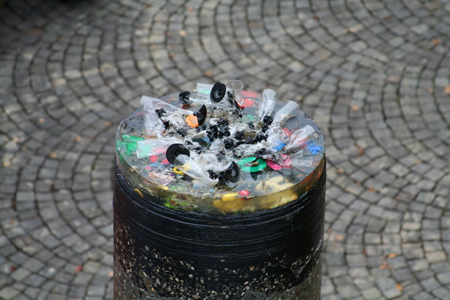
Mo(NU)mentum is a monument for the future, visualizing the impossibility to continue the current evolution. It is a permanent memory and trace of Generali Groups Executive Forum on Time: Business Opportunity and Strategic Timing. The best Champagne was served in plastic Champagne glasses. The empty glasses were collected and melted on top of the installation, thereby physically contributing the last layer.
Posted in Archaeology, Barology, Horology, Stratigraphy, Visual Arts | 4 Comments »
september 8th, 2008
Maarten Vanden Eynde
Plato’s Closet, 2008 A.D.
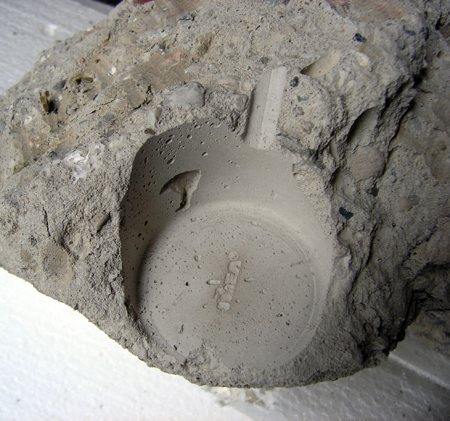
When the IKEA catalogue became the most printed book in human history (beating the bible for the first time ever) it was clear that a new geological layer was added around the millennium, 2000 A.D., consisting mainly of IKEA products. In the future this period in time would become known as the IKEA-era. It took several centuries before their imperium was going in decay disappearing under the next layer of history. This negative fossil is one of the oldest remains of an IKEA closet, containing traces of a lamp and cup which probably stood on the closet. The left over void functions as a mother-mould enabling reproduction forever.
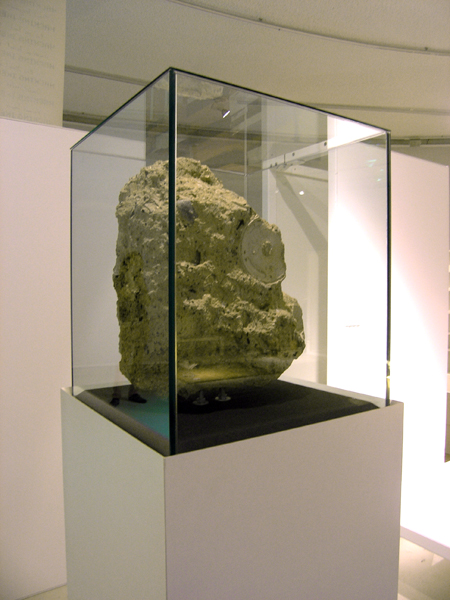
This work was made in the context of the exhibition ‘Hacking IKEA’ at Platform21. Original IKEA products: MALM closet, KVART lamp, LJUVLIG cup
POMPEI, Italy
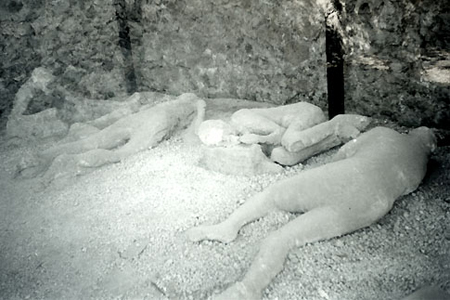
Plaster moulds of people buried by ash and lava from the erruption of Mt Vesuvius that obliterated Pompei in 79 A.D. (The garden of the fugitives).
These mold formations were discovered as early as 1860 by one of the first archaeologists at Pompei, Giuseppe Fiorelli. He is credited with developing the process by which the molds – one might call them negatives in clay – are turned into the positive plaster forms. The technique was further refined by the archaeologist Amadeo Maiuri, who was in charge of Pompei excavations for much of the present century.
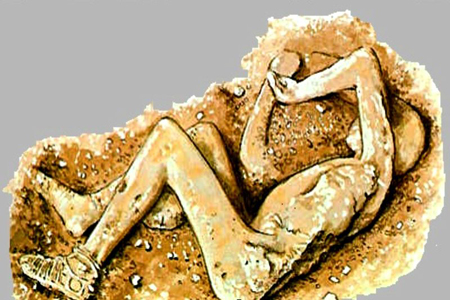
Posted in Archaeology, Petrology, Visual Arts | 1 Comment »



















































